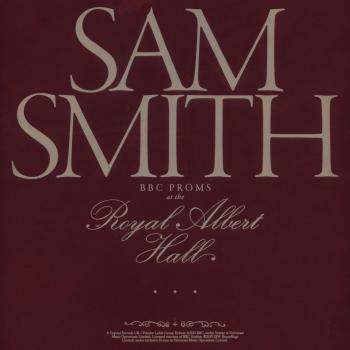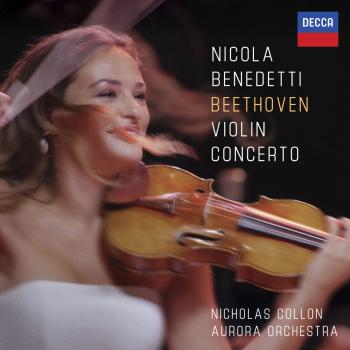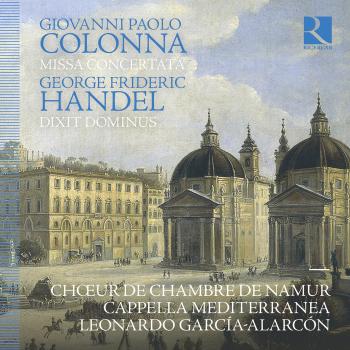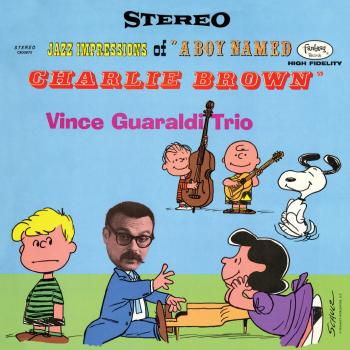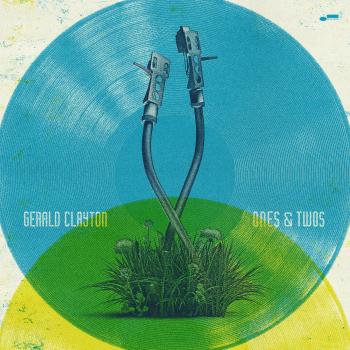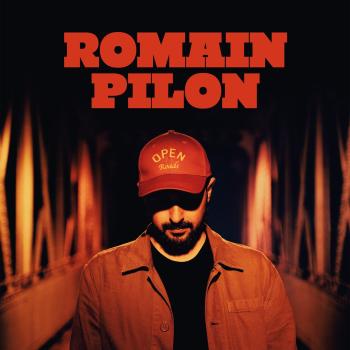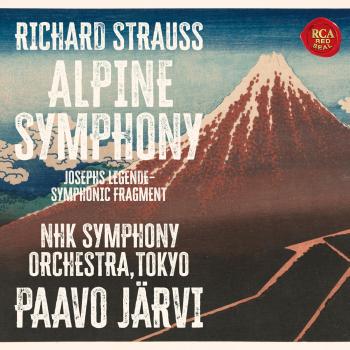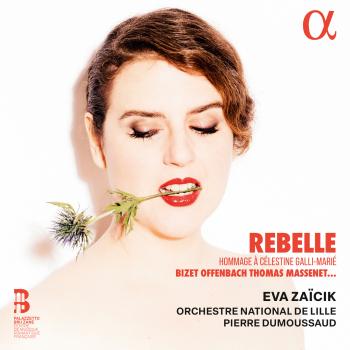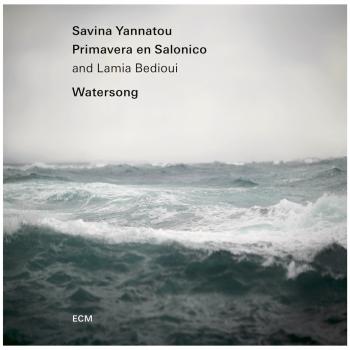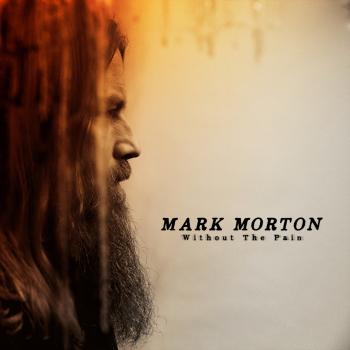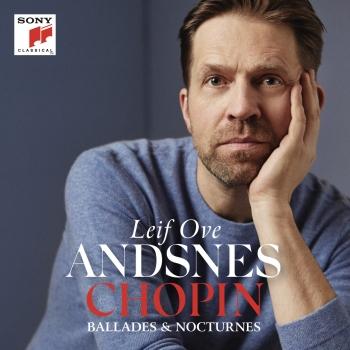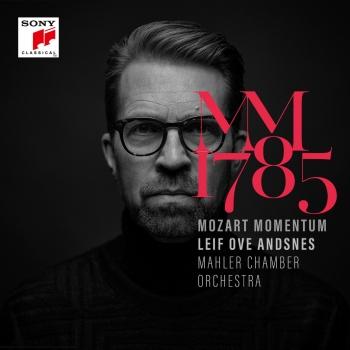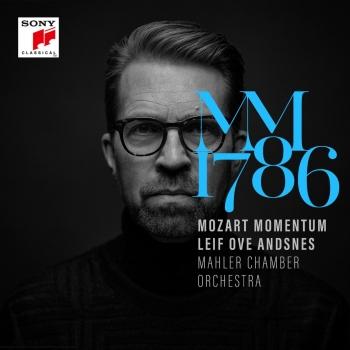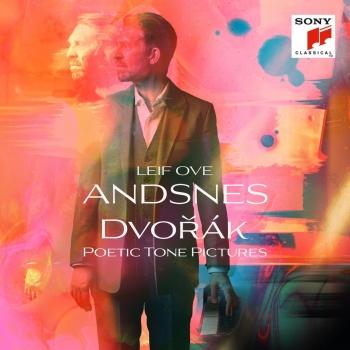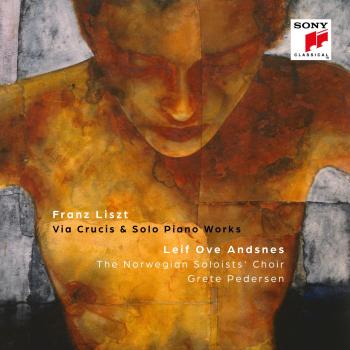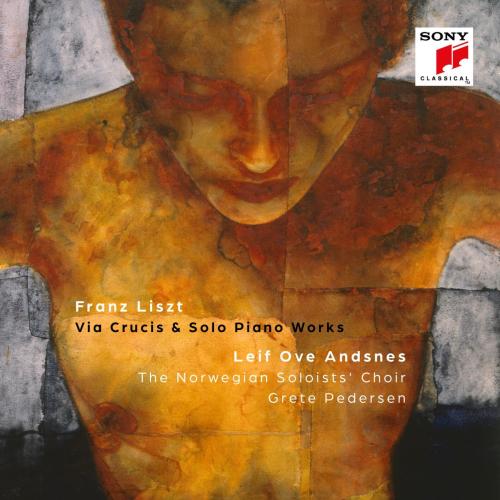
Liszt: Via Crucis & Solo Piano Works Leif Ove Andsnes
Album info
Album-Release:
2025
HRA-Release:
11.04.2025
Label: Sony Classical
Genre: Classical
Subgenre: Choral
Artist: Leif Ove Andsnes
Composer: Franz Liszt (1811-1886)
Album including Album cover Booklet (PDF)
I`m sorry!
Dear HIGHRESAUDIO Visitor,
due to territorial constraints and also different releases dates in each country you currently can`t purchase this album. We are updating our release dates twice a week. So, please feel free to check from time-to-time, if the album is available for your country.
We suggest, that you bookmark the album and use our Short List function.
Thank you for your understanding and patience.
Yours sincerely, HIGHRESAUDIO
- Franz Liszt (1811 - 1886): Via Crucis, S. 53:
- 1 Liszt: Via Crucis, S. 53: Vexilla regis 03:49
- 2 Liszt: Via Crucis, S. 53: Station I: Jesus wird zum Tode verdammt 01:01
- 3 Liszt: Via Crucis, S. 53: Station II: Jesus trägt sein Kreuz 02:13
- 4 Liszt: Via Crucis, S. 53: Station III: Jesus fällt zum ersten Mal 01:11
- 5 Liszt: Via Crucis, S. 53: Station IV: Jesus begegnet seiner heiligen Mutter 02:12
- 6 Liszt: Via Crucis, S. 53: Station V: Simon von Kyrene hilft Jesus das Kreuz tragen 02:30
- 7 Liszt: Via Crucis, S. 53: Station VI: Sancta Veronica 01:57
- 8 Liszt: Via Crucis, S. 53: Station VII: Jesus fällt zum zweiten Mal 01:11
- 9 Liszt: Via Crucis, S. 53: Station VIII: Die Frauen von Jerusalem 02:14
- 10 Liszt: Via Crucis, S. 53: Station IX: Jesus fällt zum dritten Mal 01:13
- 11 Liszt: Via Crucis, S. 53: Station X: Jesus wird entkleidet 01:31
- 12 Liszt: Via Crucis, S. 53: Station XI: Jesus wird ans Kreuz geschlagen 00:52
- 13 Liszt: Via Crucis, S. 53: Station XII: Jesus stirbt am Kreuze 05:58
- 14 Liszt: Via Crucis, S. 53: Station XIII: Jesus wird vom Kreuz genommen 03:20
- 15 Liszt: Via Crucis, S. 53: Station XIV: Jesus wird ins Grab gelegt 04:31
- 16 Liszt: Consolations, S. 172: No. 1 in E Major. Andante con moto 01:27
- Consolations, S. 172:
- 17 Liszt: Consolations, S. 172: No. 2 in E Major. Un poco più mosso 02:53
- 18 Liszt: Consolations, S. 172: No. 3 in D-Flat Major. Lento placido 04:11
- 19 Liszt: Consolations, S. 172: No. 4 in D-Flat Major. Quasi adagio 02:41
- 20 Liszt: Consolations, S. 172: No. 5 in E Major. Andantino 02:08
- 21 Liszt: Consolations, S. 172: No. 6 in E Major. Allegretto sempre cantabile 02:30
- Harmonies poétiques et religieuses, S. 173:
- 22 Liszt: Harmonies poétiques et religieuses, S. 173: No. 9. Andante lagrimoso 07:14
- 23 Liszt: Harmonies poétiques et religieuses, S. 173: No. 8. Miserere, d'après Palestrina. Largo 03:33
Info for Liszt: Via Crucis & Solo Piano Works
On his latest album “Liszt: Via Crucis & Solo Piano Works”, releasing on Aprill 11 2025 for Sony Classical, Norwegian pianist Leif Ove Andsnes unveils the often forgotten side of the famed virtuoso Franz Liszt - the sacred music that offers a more intimate picture of the man and his deeply held faith.
With acclaimed vocal ensemble the Norwegian Soloists’ Choir, Andsnes has recorded Liszt’s remarkable late work Via Crucis (The Way of the Cross’) for choir and piano. The pianist completes his all-Liszt album with the solo piano work Consolations and two movements from the composer’s Harmonies poétiques et religieuses.
Franz Liszt is often described as the ‘first virtuoso’ - a superstar pianist and composer who invented the piano recital and whose fame and following in the nineteenth century were unprecedented. Much of Liszt’s reputation hangs on sweeping virtuosic showpieces so technically challenging that only Liszt could play them.
But that is only half the story. In 1847, at the age of just 35, Liszt retired from public performance to focus on writing and teaching. Thirteen years later he took another step back, taking Holy Orders and embarking upon a new life of religious devotion and creative introspection.
In this later period, a new aesthetic took root in Liszt, one characterized by austere, spare and sometimes inscrutable musical utterances that tended to question more than they assert. ‘I find Liszt’s religious music fascinating,’ says Andsnes, who has lived with Liszt’s music since childhood. ‘This is very different music, with so few notes but with a tension and beauty.’
One of the major statements of Liszt’s late period was Via Crucis, a journey through the Roman Catholic tradition’s Stations of the Cross for choir and piano, written in Rome in 1866 but considered too unusual by Liszt’s publisher and never performed in the composer’s lifetime. It wasn’t until 1929 that the work was given its first airing, on Good Friday, in the capital of the composer’s native Hungary, Budapest.
Via Crucis is unlike any other work in the repertoire: a concentrated ritual drama, ranging from liturgical chant to Lisztian chromaticism at its most searching and expressive. It sets a pianist and choir in dialogue with one another, each performing alone as well as together.
‘This is something very different,’ says Andnsnes. ‘It is incredible, the journey Liszt made as a composer, from this very flamboyant virtuosic style to [Via Crucis], which is very bare, with so few notes, but still an incredible tension and beauty. It points forward to the twentieth century while also building on the tradition of scared music.’
The work’s unusual scoring gave Andsnes the opportunity to extend his longstanding collaboration with the Norwegian Soloists’ Choir - one of the finest vocal ensembles in the world and a seasoned recording group, consisting of 26 handpicked professional singers.
‘Via Crucis tells a story about a man who gave his life for others, and at the same time is so much about humanity,’ says Grete Pedersen, artistic director of the choir; ‘it is a piece with a lot of question marks, and I hope listeners will feel that.’
‘We live in a world of pain and conflict and Via Crucis offers room for empathy, for philosophical thought, and for the taking-in of different emotions,’ says Andsnes. ‘Audiences seem to be mesmerized by it. It really is a special work in which you can discover so much beauty.’ He likens the work to ‘14 miniature tone poems’.
The musicians examined the piece extensively before recording it together in Oslo, performing it in concert and attempting to fathom is unusual scoring in which piano and choir are sometimes partners yet sometimes sound diametrically opposed.
‘It was inspiring to be in the middle of the sound of a choir of this quality,’ says Andsnes; ‘I was inspired by the exacting way Grete and the Soloists’ Choir do these things. Their attention to detail is so great, which is important in music that is so fragile.’ Grete Pedersen comments: ‘if any pianist can make the piano sing, it’s Leif Ove.’
Completing the programme is music from two earlier cycles by Liszt that prove there was always more to his musical outlook than showmanship and virtuosity. A mood of thoughtful reflection dominates the composer’s Consolations, written on the eve of the composer’s retirement from public performance and in a paired-back idiom that alternates the lyrical, the winsome and the forthright before dissolving into silence.
Two of the six movements are cast in the key of E major, the tonality Liszt reserved for music addressing the divine. ‘I find the Consolations so tender, so intimate, speaking from heart to heart,’ says Andsnes. ‘But still, they have different styles, from the spiritual to the dramatic. They are so wonderfully written for the piano; it always sings.’
Andsnes’s album also includes two movements from Liszt’s Harmonies poétiques et religieuses, a magnificent 10-movement cycle written in 1853, inspired by poetry by Alphonse de Lamartine. Andsnes describes the ‘Andante Lagrimoso’ as ‘full of sorrow.’
The other movement from the set, which ends the album, is something else entirely. Liszt’s ‘Miserere, d’après Palestrina’ is a startling creation written in homage to Italy’s great Renaissance polyphonic composer, which treats a chant-like theme with an almost improvisatory spontaneity. ‘It ends with an enormous flourish,’ says Andsnes, ‘it’s a relief after all the intimate music we have been through. But it also brings us back to the very beginning of the album, as the Via Crucis begins with a Gregorian chant.’
Leif Ove Andsnes, piano
Oystein Stensheim, tenor
Olle Holmgren, bass-baritone
Mari Askvik, mezzo-soprano
Norwegian Soloists' Choir
Grete Pedersen, conductor
Please Note: We offer this album in its native sampling rate of 96 kHz, 24-bit. The provided 192 kHz version was up-sampled and offers no audible value!
Leif Ove Andsnes
The New York Times calls Leif Ove Andsnes “a pianist of magisterial elegance, power, and insight,” and the Wall Street Journal names him “one of the most gifted musicians of his generation.” With his commanding technique and searching interpretations, the celebrated Norwegian pianist has won acclaim worldwide, playing concertos and recitals in the world’s leading concert halls and with its foremost orchestras, while building an esteemed and extensive discography. An avid chamber musician, he is the founding director of the Rosendal Chamber Music Festival, was co-artistic director of the Risør Festival of Chamber Music for nearly two decades, and served as music director of California’s Ojai Music Festival in 2012. He was inducted into the Gramophone Hall of Fame in July 2013, and received honorary doctorates from New York’s Juilliard School and Norway’s University of Bergen in 2016 and 2017, respectively.
Andsnes is currently partnering with the Mahler Chamber Orchestra (MCO) on “Mozart Momentum 1785/86.” A major multi-season project exploring one of the most creative and seminal periods of the composer’s career, this sees the pianist lead the ensemble from the keyboard in accounts of Mozart’s Piano Concertos Nos. 20–24 at key European venues, as well as recording them for Sony Classical. When it was released in May 2021, the project’s first album, MM/1785, was named “Record of the Week” by BBC Radio 3 and “Recording of the Month” by Gramophone magazine, which pronounced it “a remarkable achievement by all concerned.” “Mozart Momentum 1785/86” marks Andsnes’s second artistic partnership with the MCO, following the success of “The Beethoven Journey.” An epic four-season focus on the composer’s music for piano and orchestra, this took the pianist to 108 cities in 27 countries for more than 230 live performances, and is perhaps his most ambitious achievement to date. He led the MCO from the keyboard in complete Beethoven concerto cycles at high-profile residencies in Bonn, Hamburg, Lucerne, Vienna, Paris, New York, Shanghai, Tokyo, Bodø and London, besides collaborating with such leading international ensembles as the Los Angeles Philharmonic, San Francisco Symphony, London Philharmonic and Munich Philharmonic. The project was chronicled in the documentary Concerto – A Beethoven Journey (2016), and Andsnes’s partnership with the MCO was captured on the hit Sony Classical three-volume series The Beethoven Journey. The first volume was named iTunes’ Best Instrumental Album of 2012 and awarded Belgium’s Prix Caecilia, the second recognized with BBC Music’s coveted “2015 Recording of the Year Award,” and the complete series chosen as one of the “Best of 2014” by the New York Times.
Andsnes now records exclusively for Sony Classical. His previous discography comprises more than 30 discs for EMI Classics – solo, chamber, and concerto releases, many of them bestsellers – spanning repertoire from the time of Bach to the present day. He has been nominated for eleven Grammys and awarded many international prizes, including six Gramophone Awards. His recordings of the music of his compatriot Edvard Grieg have been especially celebrated: the New York Times named Andsnes’s 2004 recording of Grieg’s Piano Concerto with Mariss Jansons and the Berlin Philharmonic a “Best CD of the Year,” the Penguin Guide awarded it a coveted “Rosette,” and both that album and his disc of Grieg’s Lyric Pieces won Gramophone Awards. His recording of Mozart’s Piano Concertos Nos. 9 and 18 was another New York Times “Best of the Year” and Penguin Guide “Rosette” honoree. He won yet another Gramophone Award for Rachmaninov’s Piano Concertos Nos. 1 and 2 with Antonio Pappano and the Berlin Philharmonic. A series of recordings of Schubert’s late sonatas, paired with lieder sung by Ian Bostridge, inspired lavish praise, as did the pianist’s world-premiere recordings of Marc-André Dalbavie’s Piano Concerto and Bent Sørensen’s The Shadows of Silence, both of which were written for him. As well as Chopin: Ballades & Nocturnes and the Billboard best-selling Sibelius, both recorded for Sony, his recent releases include Stravinsky: The Rite of Spring & other works for two pianos four hands, recorded with Marc-André Hamelin for Hyperion, and Schumann: Liederkreis & Kernerlieder, recorded with Matthias Goerne for Harmonia Mundi, both of which were nominated for Grammy Awards.
Andsnes has received Norway’s distinguished honor, Commander of the Royal Norwegian Order of St. Olav, and in 2007, he received the prestigious Peer Gynt Prize, awarded by members of parliament to honor prominent Norwegians for their achievements in politics, sports, and culture. In 2004-05, he became the youngest musician (and first Scandinavian) to curate Carnegie Hall’s “Perspectives” series, and in 2015-16 he was the subject of the London Symphony Orchestra’s Artist Portrait Series. Having been 2010-11 Pianist-in-Residence of the Berlin Philharmonic, he went on to serve as 2017-18 Artist-in-Residence of the New York Philharmonic and 2019-20 Artist-in-Residence of Sweden’s Gothenburg Symphony. He is the recipient of the Royal Philharmonic Society’s Instrumentalist Award and the Gilmore Artist Award, and, saluting his many achievements, Vanity Fair named Andsnes one of the “Best of the Best” in 2005.
Leif Ove Andsnes was born in Karmøy, Norway in 1970, and studied at the Bergen Music Conservatory under the renowned Czech professor Jirí Hlinka. He has also received invaluable advice from the Belgian piano teacher Jacques de Tiège, who, like Hlinka, greatly influenced his style and philosophy of playing. Today Andsnes lives with his partner and their three children in Bergen. He is an Artistic Adviser at the city’s Prof. Jirí Hlinka Piano Academy, where he gives a masterclass to participating students each year.
Booklet for Liszt: Via Crucis & Solo Piano Works

